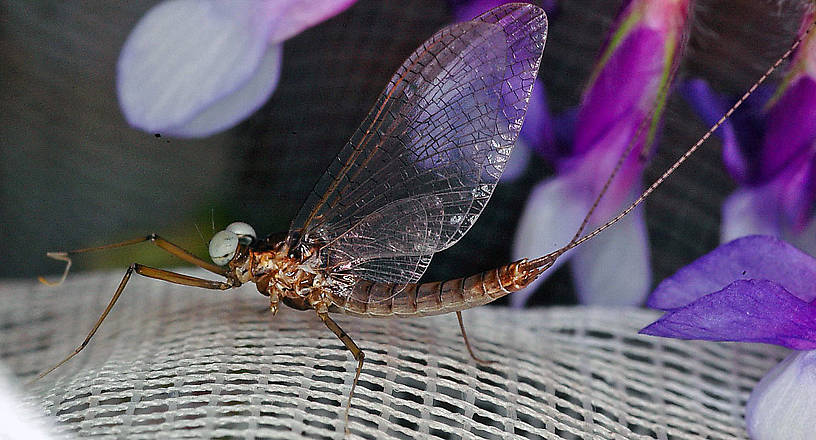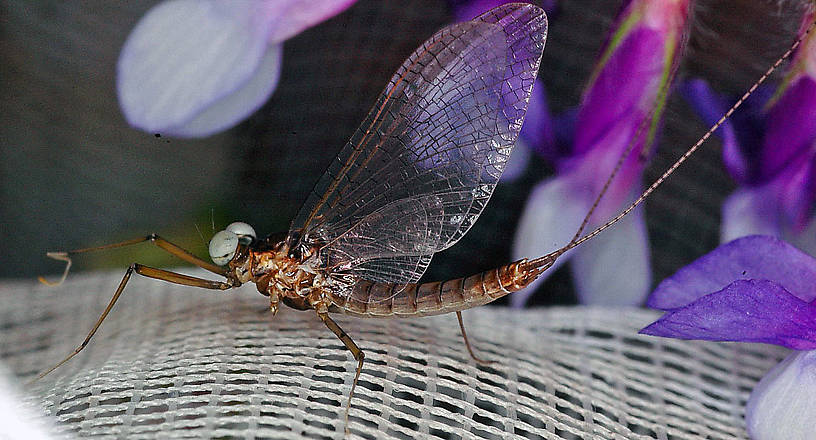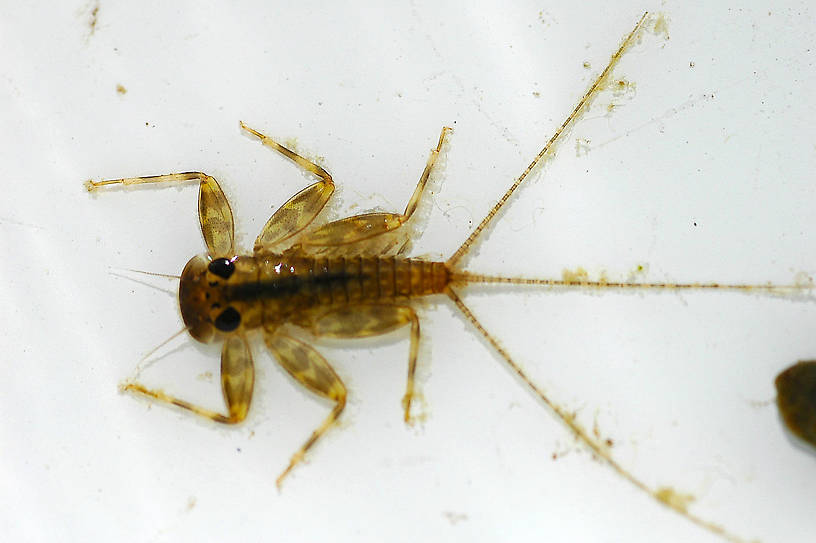
Blue-winged Olives
Baetis
Tiny Baetis mayflies are perhaps the most commonly encountered and imitated by anglers on all American trout streams due to their great abundance, widespread distribution, and trout-friendly emergence habits.

- The prosternal horn is present.
- The mandible is clearly toothed, not formed into a uniform scraper blade.
- The seems to be only 2 major setae on the ventral edge of the hind femur.
- Chloride epithelia seem to be absent from the dorsal side of any abdominal segments.
Based on these characteristics and the ones more easily visible from the pictures, this seems to be Grammotaulius. The key's description of the case is spot-on: "Case cylindrical, made of longitudinally arranged sedge or similar leaves," as is the description of the markings on the head, "Dorsum of head light brownish yellow with numerous discrete, small, dark spots." The spot pattern on the head is a very good match to figure 19.312 of Merritt R.W., Cummins, K.W., and Berg, M.B. (2019). The species ID is based on Grammotaulius betteni being the only species of this genus known in Washington state.

Mayfly Species Heptagenia solitaria (Ginger Quills)
Where & when
A few authors mention fishable hatches of these mayflies in the West, but they are not among the most important species.In 15 records from GBIF, adults of this species have been collected during September (40%), July (20%), May (20%), October (7%), August (7%), and June (7%).
In 9 records from GBIF, this species has been collected at elevations ranging from 4951 to 6854 ft, with an average (median) of 5230 ft.
Species Range
Physical description
Most physical descriptions on Troutnut are direct or slightly edited quotes from the original scientific sources describing or updating the species, although there may be errors in copying them to this website. Such descriptions aren't always definitive, because species often turn out to be more variable than the original describers observed. In some cases, only a single specimen was described! However, they are useful starting points.
Male Spinner
Wing length: 11 mm
Mesonotum with dark brown median stripe; costal margin of fore wing tinged with pale lemon yellow; cross veins brown; dark dorsal stripe on abdomen; genitalia of the Heptagenia pulla type; probably allied to that species.
Head light brown; black dash on frons next to eye, below base of antenna; vertex with ruddy tinge. Thoracic notum brown, with a deeper brown mid-dorsal stripe, most evident on anterior portion of mesonotum. Pleura pale ochreous brown; short black streaks just beyond bases of middle and hind coxae, and similar streaks above these, in line with wing roots; all of these dark markings may be obscure. Legs pale yellowish brown; all the femora, the fore tibia, and joints of the fore tarsus tipped with purplish. Basal joint of fore tarsus about 1/4 of the second; basal joint of hind tarsus slightly shorter than second. Wings hyaline; costal margin tinged with pale lemon yellow. Basal half of subcosta and radius thickened, pale yellowish; other longitudinal veins fine, deep brown. Cross veins thicker than longitudinals, especially along the costa; deep brown.
Abdominal segments very pale brownish. Tergites 2-7 with a dark purplish-brown median stripe enclosing a narrow pale mid-dorsal line; on posterior margins a narrow dark band of same color, with submedian broad dark bands projecting forward from it, but not attaining the anterior margin. The dark dorsal and submedian stripes may coalesce to form a simple dark shading, or with paler lunate marks submedially from the anterior margin. Tergites 8-10 opaque, light reddish brown; sternites paler. Forceps ochreous; tails dull ochreous, joinings narrowly brown. Genitalia of the pulla type; upper pair of median spines smaller than lower ones.
Larger and paler than H. criddlei (now a synonym of Ecdyonurus criddlei) another dark species of this group; apparently close to H. pulla, but rather darker in color markings, and with darker legs and tails.
Specimens of the Mayfly Species Heptagenia solitaria
2 Male Spinners
1 Nymph
Start a Discussion of Heptagenia solitaria
References
- Arbona, Fred Jr. 1989. Mayflies, the Angler, and the Trout. Nick Lyons Books.
- Knopp, Malcolm and Robert Cormier. 1997. Mayflies: An Angler's Study of Trout Water Ephemeroptera . The Lyons Press.
- Merritt R.W., Cummins, K.W., and Berg, M.B. 2019. An Introduction to the Aquatic Insects of North America (Fifth Edition). Kendall/Hunt Publishing Company.
- Needham, James G., Jay R. Traver, and Yin-Chi Hsu. 1935. The Biology of Mayflies. Comstock Publishing Company, Inc.
Mayfly Species Heptagenia solitaria (Ginger Quills)
Species Range
Common Names
Resources
- NatureServe
- Integrated Taxonomic Information System
- Global Biodiversity Information Facility
- Described by McDunnough (1924)




